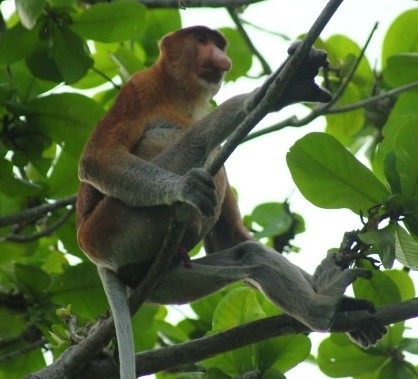Borneo…3 years ago this month…so excited to be approaching another land of animals in Africa! We will spend a year in East Africa,so we will hopefully be able to take many photos! 













Borneo. The name has that wild air to it; pigmy head hunters, wild men, jungles. I googled “wild man of Borneo”, terms I remember from movies my parents and grandparents had watched. Actually there were two wild men from Borneo, but in reality they were two dwarfs from Massachusetts that a carnival promoter had dressed up in furs and primeval garb, waving long spears. But who would ever catch on; who has ever been to Borneo, especially in our grandparents day?
Indonesia, on the east, and Malaysia, on the west, share the island of Borneo. From either country, you can venture inland or up narrow tributaries to marshes full of large crocodiles, exotic proboscis monkeys, the parochial orangutan, bearded wild boar and all sorts of other unique animals. Fortunately the natives are friendly. Conveniently, the language in Malaysia is as similar to Indonesian as American is to British or Australian. After 7 months wandering through Indonesia, we did what we could to pick up rudiments of that language so now we get two languages for the effort of one.
We were happy to put Indonesia over the horizon on our stern. Bali was a bust. The yacht agent at the neighboring island of Lombok and her coconspirator customs man, were combing our ships papers looking for any questionable marks for which to hold us ransom. But we held our ground and left town without bending to their corruption. But what a surprise clearing into the small country of Malaysia. The customs, immigration and harbormaster were all happy to have us enter their country. When seeing we are from the U.S., they would always exclaim “America, Obama!”. Everything happened so fast, so friendly, so uncorrupted, with a minimum of paperwork, we thought something had to be wrong, which might cause us problems later on. We had forgotten how a modern country works. In fact, they didn’t even ask for our clearance papers from Indonesia, the papers we had such a difficult time getting. Finally, we arrived in the land of educated people, normality.
And a modern country it is. The city of Kuching is as nice as any Australian or American small city, complete with divided 4 lane roads and long lines of rush hour traffic in the morning and evenings. New cars and SUVs were bumper to bumper. There are motorcycles, but not the heavy swarms that move more like herds clogging roads in other countries. This attests to the wealth of Malaysia. Oil rigs near shore and oil terminals on land help to finance the upscale lifestyle. Kuching in Malaysian means “cat”. There are a couple cat statues around the city, and of no great interest, a cat museum, but very few live cats roam around. No one really knows how the city wound up with its name but it is thought that an early native word was mistaken for “kuching” and when the Europeans arrived, and stayed, “Kuching” stuck.
We were anchored just inside of a muddy river at Santubang, 25 easy driving miles into the country. So we had country living with easy access to the big city via an inexpensive shuttle van that traveled the route several times a day. And to make it even better, one of the wealthiest people in Malaysia owns water front property where he operates a fish farming enterprise. His floating docks are there for visiting cruisers to tie their dinghies to and have free access to the water faucets. Anywhere else we have been in the world, someone would have been charging a significant day rate. The city water at the dock and throughout Malaysia, is healthy to drink which is quite unlike all of Indonesia and most other island nations we have visited in the Pacific.
Our first days in the Santubong and Kuching area of Malaysia gave us a big boost to our cruising attitudes, which had soured in our final days in Indonesia.
There was no shortage of activities in the Kuching area. National Parks are important to the Malaysians and they take conservation as seriously as the Americans and Australians. There were mountains to climb, park trails to explore, rare flowers and animals to spy, crocodiles and very venomous snakes to avoid and cultural events to participate in. Since Brick House was the only boat anchored in Santubong, and it would be two weeks before other cruising friends would drop anchor nearby, Rebecca and I sailed off to not so distant parks to start our explorations of the sights of Malaysia.



